Content removed at Moog’s request. The former entry included publicly accessible content provided by a reliable source, however, this content that wasn’t meant to be publicly accessible. It has been removed at the source and Moog requested we remove it from this site too. We certainly meant no harm to Animoog in any way. — Alex (aka Satri) for Animoog.org
All posts by Satri
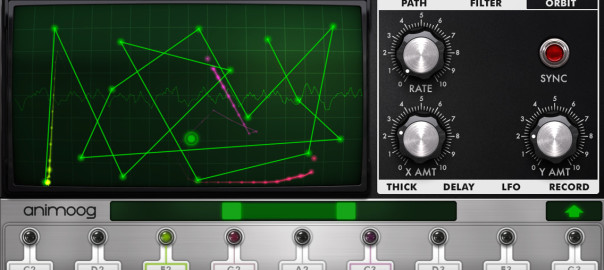
Animoog for iPhone 1.1.2 Released
This is major news, mainly because it confirms that Moog has not abandoned Animoog. Animoog for iPhone’s previous update showed up 2012. Here’s what’s new in version 1.1.2 of Animoog for iPhone, officially released on August 29th, 2014:
- Full iOS 7 compatibility
- Support for iPhone 5 and all prior screen sizes
- Inter-App Audio Support
- Audiobus 2 Support
- AudioCopy 2 Support
Audiobus and Inter-App Audio (IAA) support are significant new features, meaning Animoog for iPhone can now properly be integrated with other music apps on the iPhone. IAA is Apple’s built-in solution for iOS 7 and later for audio apps to talk together and share (and real-time modification) audio tracks. Both Audiobus and IAA are widely supported by other iOS audio apps.
What’s also great is that Moog itself provided feedback in their forum, acknowledging some issues with the just released new features and pointing to another upcoming update that should soon see the light. Moog cares, and that matters.
An update for Animoog for the iPad has not hit the App Store yet, but now we can expect it any day or week. Let’s rejoice! And yes, I’ll have to update the wish list for Animoog accordingly.
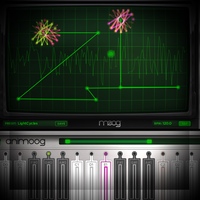
Altermoog – 30 New Free Presets for Animoog and Version 1.1 of the List of 3rd-Party Presets
Rejoice! Zen Lizard announced its 30 free presets for Animoog.
« Resonant basses & cutting leads take full advantage of the highly playable keyboard and sound fantastic. Completely free for everyone! »
These great news required me to proceed with the first update to the recently introduced list of Expansion Packs for Animoog, now at version 1.1., where you’ll find plenty other sources of free presets for our beloved instrument. There were several improvements to the list, including the addition of Moog’s BASE Pack which was missing from the initial release of the table. Thanks to an anonymous user comment , we now have the associated URLs for this BASE Pack.
If you’re aware of other sources of free presets or would like to share corrections, please let me know! Enjoy the new Altermoog presets!
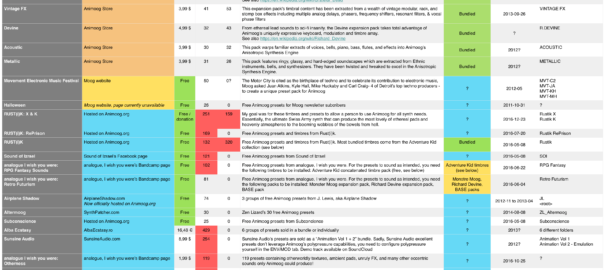
Introducing the Exhaustive list of Animoog Expansion Packs
Would you believe that expansion packs provide over 1,300 new presets and over 4,700 new timbres for you to play with in Animoog? Here’s significant value on Animoog.org for Animoog users – an exhaustive list of Animoog expansion packs documentation. Why it’s useful?
« Lots of expansion packs can be purchased and installed directly from within the Animoog app under the ‘STORE’ tab, however, several high-quality presets and timbres are not available from within the app itself — that’s the value of the following table, to help us find those valuable gems no matter where they hide! »
Instead of copying the whole new page, just take a look at it. It’s far from what I had in mind initially, but what matters is that it exists now, and thanks to community contributions, I hope it’s going to dramatically improve over time!
The new table is available as a png, a pdf and as an interactive table. The content of the table is also available on Github. As usual, any contribution is welcomed.
Other recent updates on Animoog.org
There were also a few other significant improvements to the site, such as more precise Welcome page indicating what is actually available on the site vs what is planned. I also added a new section in the Animoog improvements wish list regarding inter-app connectivity.
Take care! — Alex, aka Satri
Playing multiple presets on a single Animoog
Another ‘important’ potential improvement for Animoog I forgot to include in the improvements wish list. It’s there now.
The new content:
[…] with two rows of keyboard input, playing two different Animoog presets on the same screen becomes possible. When Animoog was launched, iPads and iPhones were far from delivering as much performance as today (over 5x increase between the iPad 2 and iPad Air). Yes, such a feature would have impact of many other aspects of the app (such as midi messages, 4-tracks recording, two xy pads?, etc), but at the same time, would bring Animoog to another level of blissfulness
I’m excited by this possibility of playing two Animoog presets at the same time (on a single iPad)… that would dramatically extend Animoog’s expressiveness capabilities. Do you agree?
Anicontrol and a Custom Animoog Controller
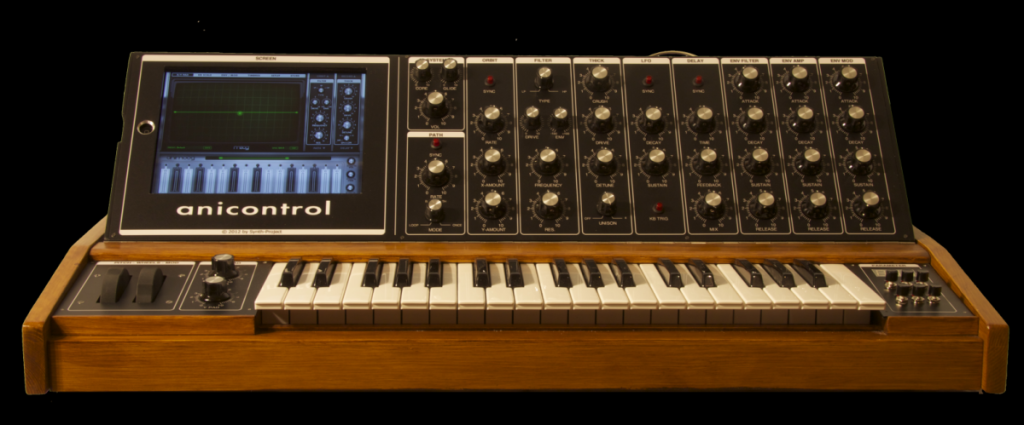
I’ve known about Anicontrol since March, but this latest post on Discchord showing another custom Animoog controller makes me share their existences with you!
The Synth-Project offers a page on Anicontrol, pictured above, an Animoog controller with the iPad inside. From their description: “It’s specially designed for Moog’s iOS app. And works as a stand alone synth. The front panel is tiltable, like a Minimoog or Voyage. The controller has a 3 octave keyboard, pitch & modwheel […] there are two knobs for the X and Y pad of Animoog. The main front panel has 31 knobs and 5 switches to control the most important parameters of the Animoog app.”
The second similar project is Vladimir Kolomiets’ Animoog Midi Controller shown in the video below.
I admit I am personally fond of using Animoog directly on the iPad. I tried a few times playing Animoog with a midi keyboard, and I dramatically miss the capability to slide fingers in any direction to modulate Animoog sounds. I guess I’d need a giant touchpad-like controller to fully leverage what I like from Animoog’s expressive capabilities.
That said, I’m not representative myself of Animoog players, and clearly there’s capable people putting lots of Love in building their own Animoog controllers. There’s plenty different ways of enjoying Animoog!
Releasing Animoog as open source?
I wasn’t planning to write about that, but the suggestion on Moog’s forum encouraged me to share the following.
I’m a heavy user, supporter and sporadic contributor to open source and free software, so this suggestion captured my interest! Don’t hesitate to help me understand why you’d like Animoog to be open sourced if you have such inclination.
Software lives and dies according to the developer care they get. This is true for both proprietary and open source software. Developers can be paid or do it on their own time, but when a piece of software gets no time and love from developers, development has effectively halted and its days are numbered. Software development for anything even slightly complex, and Animoog certainly is in the sophisticated category, requires serious expertise and resources. You need people dedicated to coordinating the code and changes to the code, handling the bugs, priorities, feature requests, the releases, etc.
Software lives and dies according to the developer care they get
What about Animoog? Yeah, it’s been almost a year now since the last Animoog release. Has it been abandoned by Moog? I doubt it. Especially considering Animoog’s sound engine is driving Moog’s Theremini which was just announced last month. Could Animoog be improved? It’s clearly the case as we can see from this fan-generated wish list of improvements. But the truth is that Animoog is currently working fine and as great as last year. Analog pianos and guitars haven’t changed much in past decades and that does not reduce their quality, popularity or ability to do what they were built to accomplish.
Would Animoog be better of as open source, in the hands of a community coordinated by Moog? I’m not certain. As much as several of us can be dedicated to Animoog, there probably isn’t that many of us with the time and required expertise to develop Animoog at a quicker pace than Moog. I suspect it makes more sense for Moog to sell the app, and numerous users are happy to pay for it and its in-app purchases, and Moog to use that money to further develop Animoog, than hope for a community to organize itself and actually deliver sustained and coordinated improvements to Animoog. But hey, I could be wrong!
I suspect it makes more sense for Moog to sell the app, and numerous users are happy to pay for it and its in-app purchases, and Moog to use that money to further develop Animoog […]
With an open source Animoog, Moog will most probably get less revenue from it and consequently will devote less time to improve it. Another scenario would be that with Animoog becoming free, the increase in users and associated potential increase of in-app purchases would be enough to fill that revenue gap for having the core of Animoog open source. That scenario appears unlikely to happen, and at a minimum it’s a pretty big risk if revenue is important to Moog.
If Moog decides to drop Animoog’s development in favor of other priorities, sure, providing it as open source makes all the sense in the world (software code can be open source but still be proprietary, there’s a difference between open source software and free software). Otherwise, despite being a heavy user and supporter of open source, I’m not convinced that it would actually help for the future of the instrument we love.
There’s an infinity of opportunities. Another scenario would be for Moog to keep Animoog’s core closed, but provide an API that would allow developers to extend Animoog through in-app purchases – those extensions could be either for a fee, free or open source. That could be the best of both worlds. But it also means Moog would have to spend time providing and documenting an API for third-party developers to leverage.
What do you think? Should Animoog become open source? Why? And how?
Update to the Animoog Wish List
Thanks to the feedback provided on the official Animoog forum and the addition of some important items I forgot for the initial publication of the page, the Animoog improvements wish list is now significantly improved! Additions include:
- A new section on transferring and the syncing of tracks, presets and timbres, copied below
- In-app tutorials
- Animoog for Android
- and a few other minor enhancements and wishes
Here’s the whole new section we added as part of this update:
Presets and tracks transfer and sync
- Getting data in and out Animoog could be much easier and straightforward, especially for (A) 4-track projects, and (B) user-saved presets and timbres
- For tracks, we can use ‘AudioCopy’ to move to Garageband and then export away, or use Audiobus to export to yet another app. For copying presets out, we currently have to rely on iFunBox. In both cases, it requires lots of manipulations and third-party software
- What about a simple ‘Send by email’ feature for tracks? That would be a great start
- Tracks and user-saved presets could also be synced in and out via DropBox, ownCloud or a similar file syncing services, that would really be easy to use and immensely useful
- Moog could be rightfully worried that paid-for presets and timbres could be shared amongst users if they becomes easy to share them. I suggest the following solution; let Animoog users share the presets they modified and are proud of, let them build a sense of community around sharing user-modified presets and timbres, but in order to avoid the piracy of presets sold as in-app purchases, make it a requirement that in order to use a preset coming from another user, someone has to have bought, if applicable, the original preset on which the shared preset is based on. Technically, Animoog simply needs to validate that the preset the user is loading is based on a preset that the user already has rights to, if not, let the user know that it needs to buy the original preset in order to use the modified preset
- Tracks could be pushed to SoundCloud directly, but this is of lower priority in my opinion
Here’s the Animoog improvements wish list for you to see its latest shiny version. Don’t hesitate to share your feedback and own wishes, I’ll gladly update the page accordingly.
Sincere regards — Alex for Animoog.org
Moog Announces Animoog-based Theremin – The Theremini
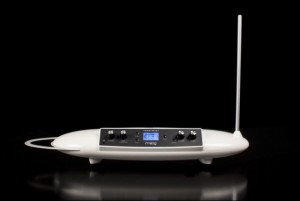
Major news! Moog announced today the Theremini, which is essentially a modern Theremin leveraging the Animoog sound engine.
From the official announcement:
“It is the only known instrument that you play without touching. Moving your hands in the space around its antennas controls pitch and volume. The Theremini combines a powerful sound engine derived from Moog’s award winning synthesizer, Animoog, with the traditional no-touch playing of a Theremin.”
The Theremini brings lots of versatility compared to the original Theremin. The features that excites me:
- 32 built-in presets, and certainly more to come eventually — meaning you can out of the box play with various rich sounds, thanks to the Animoog engine
- Pitch correction with selectable scales and root note — suddenly making the Theremini easy to play by preventing us to play any wrong note
- Adjustable stereo ping-pong delay
- and lots more…
The full list of features is available on the Moog website. Want to look and hear what is sounds like? Here’s Moog video included in the announcement:
While I want to focus the Animoog.org website on Animoog itself, don’t be surprised if I share with you Theremini news from time to time, hey, the Theremini is really based on the Animoog engine. And my wife is open to the idea of buying one… :-)

4,300 Free Timbres for Animoog!
I wasn’t planning to spend time on documenting Animoog timbres before addressing expansion packs and presets… but an unexpected pleasant surprise over the Moog Forums led me to share with you Adventure Kid’s 4,300 free timbres now converted for Animoog and available under a Creative Commons license.
Head to the new Timbres page for the download links and all the details.